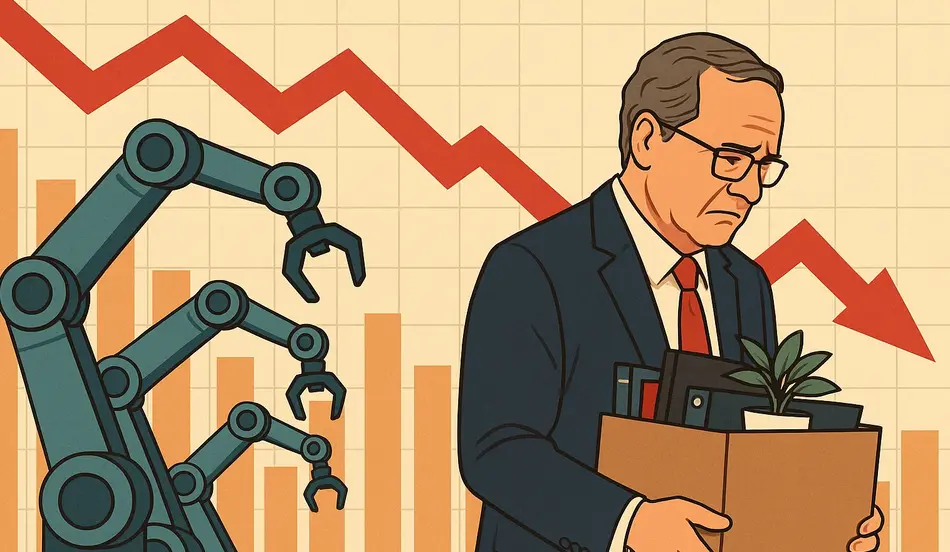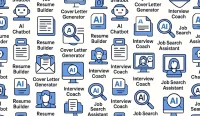The Hidden Crisis: AI Replacing Middle Class Jobs at Unprecedented Speed
The technological revolution promised by artificial intelligence has arrived, but with consequences few anticipated. While tech giants like Microsoft, Amazon, Meta, and Google report record-breaking profits—collectively earning nearly $268 billion in 2024—these gains have come at a devastating cost: the systematic elimination of middle-class jobs across America.
Despite exceeding analyst expectations on both revenue and profit margins, Microsoft recently announced plans to lay off approximately 6,000 employees. This pattern repeats across the tech landscape, with companies like Meta, Google, and Amazon collectively dismissing tens of thousands of workers—primarily from middle-skill positions that once served as reliable pathways to economic stability.
The Widening Wealth Gap: AI’s Unintended Consequence
The digital revolution has created unprecedented wealth for those with the specialized skills to capitalize on AI advancements. However, this prosperity remains concentrated among a small segment of society while simultaneously eliminating what economists term “middle-skill jobs”—positions that historically provided economic mobility for millions of Americans.
This technological displacement is fundamentally different from previous industrial revolutions. Unlike earlier transitions where workers could retrain for emerging sectors, AI’s ability to learn and perform increasingly complex tasks threatens to permanently shrink the middle class.
How AI Is Systematically Dismantling Middle-Class Career Paths
The Changing Power Dynamic Between Workers and Employers
For generations, workers maintained bargaining power through their essential role in production processes. Today, that leverage is rapidly eroding as companies deploy AI systems that operate without salaries, benefits, sick days, or labor disputes.
These AI systems offer compelling advantages to employers:
- 24/7 operational capability without overtime costs
- No healthcare or retirement benefits
- No vacation time or personal leave
- Consistent performance without human variability
- Scalable deployment across multiple business functions
The result is a fundamental shift in the employer-employee relationship, with companies increasingly viewing human workers as optional rather than essential components of their business models.
Industries Most Vulnerable to AI Displacement
While no sector remains entirely immune to AI disruption, certain industries face particularly high risks of middle-class job elimination:
- Customer service and support: AI chatbots and virtual assistants are replacing call center representatives and customer service teams
- Administrative roles: Scheduling, document processing, and basic office management functions are increasingly automated
- Financial services: Loan officers, insurance underwriters, and financial analysts see their analytical work performed by algorithms
- Healthcare administration: Medical billing, coding, and records management increasingly handled by specialized AI
- Retail management: Inventory optimization and staffing decisions now determined by predictive algorithms
According to recent research from McKinsey, approximately 45% of current paid activities could be automated using already-demonstrated technologies, representing approximately $16 trillion in wages globally.
The Economic Impact: Beyond Individual Job Losses
Shrinking Middle Class and Growing Inequality
The elimination of middle-skill jobs directly contributes to America’s growing wealth disparity. As these positions disappear, workers face difficult choices: compete for fewer remaining middle-class opportunities, accept lower-paying service jobs, or attempt to acquire advanced skills for high-paying roles that remain in demand.
This bifurcation of the job market creates what economists call a “barbell economy”—with growth at the high and low ends of the wage spectrum, but a hollowing out of the middle that once provided economic stability for millions of families.
The consequences extend beyond individual financial hardship to impact broader economic health:
- Reduced consumer spending power as middle-class incomes decline
- Decreased housing affordability in metropolitan areas
- Diminished retirement savings and financial security
- Increased reliance on government assistance programs
- Growing political and social instability from economic anxiety
The Corporate Profit Paradox
While workers struggle with displacement, major tech companies report extraordinary financial results. This stark contrast raises important questions about how productivity gains from AI should be distributed throughout society.
In 2024 alone:
- Amazon exceeded revenue projections by $3.2 billion
- Microsoft reported a 17% increase in cloud services revenue
- Google’s parent company Alphabet saw advertising revenue grow despite market challenges
- Meta achieved record profit margins despite significant headcount reductions
This divergence between corporate prosperity and worker displacement represents one of the most significant economic challenges of our time—one that requires thoughtful policy responses and corporate responsibility.
Adapting to the AI Revolution: Strategies for Displaced Workers
Identifying AI-Resistant Career Paths
While many middle-skill jobs face elimination, certain career paths demonstrate greater resilience to AI displacement:
- Skilled trades: Electricians, plumbers, HVAC technicians, and other hands-on specialists perform work that remains challenging to automate
- Healthcare practitioners: Nurses, therapists, and direct care providers combine technical knowledge with human empathy that AI cannot replicate
- Creative professionals: Original content creation, artistic expression, and innovative design continue to require human creativity
- Complex problem-solving roles: Positions requiring adaptation to novel situations and integration of multiple knowledge domains
- Human-centered services: Roles centered on building relationships, providing emotional support, or delivering personalized experiences
These fields often share common characteristics: they require physical presence, emotional intelligence, creative thinking, or complex decision-making in unpredictable environments—all areas where AI currently struggles.
Essential Skills for the AI Economy
For workers seeking to remain competitive, developing the following capabilities can help complement rather than compete with AI systems:
- Advanced digital literacy: Understanding how to work alongside AI tools rather than being replaced by them
- Critical thinking: Evaluating AI outputs and recognizing when human judgment should override algorithmic recommendations
- Emotional intelligence: Providing the human connection and empathy that technology cannot replicate
- Adaptability: Quickly learning new skills as technology continues to evolve
- Specialized knowledge: Developing expertise in areas requiring contextual understanding and nuanced judgment
Hiring? Find AI-Ready Talent Today
Many of these in-demand skills represent uniquely human capabilities that complement rather than compete with artificial intelligence.
Post jobs for free with WhatJobs and connect with candidates who have the skills to thrive in the AI economy.
🚀 Post Jobs FreeThe Policy Challenge: Balancing Innovation and Worker Protection
Rethinking Education and Training
As AI continues to transform the employment landscape, educational systems must evolve to prepare workers for this new reality. This includes:
- Emphasizing uniquely human skills alongside technical knowledge
- Creating accessible pathways for mid-career retraining
- Developing lifelong learning models that allow for continuous skill development
- Forming stronger partnerships between educational institutions and employers
Several promising educational innovations are emerging to address these challenges, including micro-credentials, competency-based education, and AI-powered personalized learning platforms.
Corporate Responsibility in the AI Transition
Companies implementing AI systems that displace workers have both ethical and practical reasons to support transition strategies:
- Funding retraining programs for displaced employees
- Creating internal career pathways to move workers into emerging roles
- Sharing productivity gains through improved compensation for remaining staff
- Partnering with communities to develop local economic resilience
Progressive companies recognize that maintaining a stable middle class serves their long-term interests by preserving consumer purchasing power and social stability.
Policy Considerations for the AI Economy
Policymakers face complex questions about how to manage the AI transition while preserving economic opportunity:
- Exploring new models of worker protection beyond traditional employment
- Considering how productivity gains from automation should be shared
- Investing in infrastructure that creates new job opportunities
- Modernizing safety net programs to address technological unemployment
- Developing regulatory frameworks that encourage responsible AI implementation
These policy discussions will shape how broadly the benefits of AI advancement are distributed throughout society.
Looking Forward: Creating a More Inclusive AI Future
The current trajectory of AI development and implementation threatens to further concentrate wealth and opportunity. However, with thoughtful approaches from businesses, policymakers, and individuals, we can work toward a future where technological advancement benefits broader segments of society.
This requires moving beyond simplistic narratives about technological inevitability to make conscious choices about how we develop, deploy, and regulate AI systems. By prioritizing human wellbeing alongside innovation, we can harness AI’s potential while preserving economic opportunity for all.
The challenge before us is not merely technical but deeply social: how to ensure that the extraordinary productivity gains from artificial intelligence strengthen rather than undermine the middle class that has long been the foundation of economic stability.
FAQ About AI Replacing Middle Class Jobs
What types of middle class jobs are most vulnerable to AI replacement?
The middle class jobs most vulnerable to AI replacement include administrative positions, customer service representatives, financial analysts, paralegals, and certain types of managers. These roles often involve predictable, routine tasks that can be systematized and automated. As AI capabilities advance, even jobs requiring more complex decision-making are becoming susceptible to automation, particularly those involving data analysis, document processing, and standardized communication.
How quickly is AI replacing middle class jobs in the current economy?
AI is replacing middle class jobs at an accelerating pace, with major tech companies alone eliminating tens of thousands of positions in 2024. Research suggests that approximately 45% of current paid activities could be automated using existing technologies. Unlike previous technological transitions that occurred over generations, AI implementation is happening rapidly across multiple industries simultaneously, giving workers less time to adapt and transition to new roles.
What skills will help protect workers from being replaced by AI systems?
To avoid being replaced by AI systems, workers should develop skills that complement rather than compete with artificial intelligence. These include emotional intelligence, creative problem-solving, complex communication, ethical judgment, and specialized technical knowledge that requires contextual understanding. Additionally, developing the ability to work alongside AI tools—understanding their capabilities and limitations—will be increasingly valuable as these systems become more integrated into workplaces.
How is the elimination of middle class jobs by AI affecting economic inequality?
The elimination of middle class jobs by AI is significantly widening economic inequality by creating a “barbell economy” with growth at the high and low ends of the wage spectrum but fewer opportunities in the middle. As middle-skill positions disappear, workers often must accept lower-paying service jobs or compete for the limited number of high-skill positions. This contributes to wealth concentration, as the economic gains from AI productivity primarily benefit company shareholders and highly-skilled workers while displacing middle-income earners.
What policy solutions could help address the middle class job losses caused by AI?
Several policy approaches could help address middle class job losses caused by AI, including expanded access to retraining programs, modernized safety net systems that recognize technological unemployment, potential exploration of universal basic income models, and tax policies that ensure productivity gains are broadly shared. Additionally, investments in infrastructure, green energy, healthcare, and education could create new middle-class opportunities while addressing critical societal needs that benefit from human workers.




